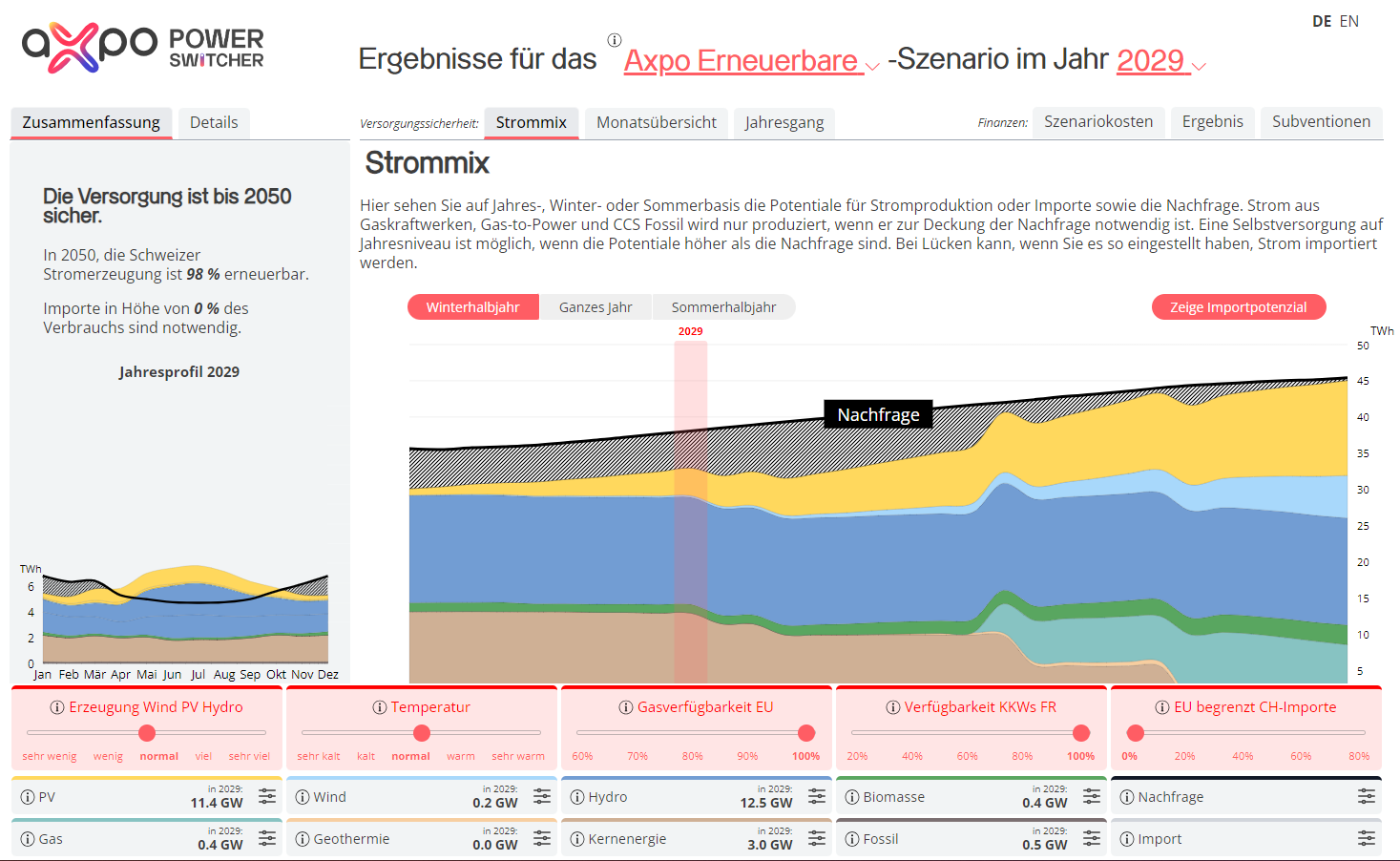05.09.2022 | A guide to initial margins and variation margins
How hedging works in energy markets

Since the sharp increase in gas and electricity prices, and in particular since Russia’s war of aggression against Ukraine, hedging transactions on the energy markets have imposed very high collateral requirements. This leads to a paradoxical situation in which even profitable companies can come under pressure.
Axpo operates power plants and produces electricity. The volume of energy that our system of power plants generates is fairly constant. That means we know how much electricity we will produce next year, and the year after that. But we do not know what the price of this energy will be in the future. It could be higher than it is today, or it could be much lower. This is a ‘blind spot’ which poses a significant risk for every energy company because they never know exactly how much to expect in revenue. So, right now, we are selling our output for a date in the future, to be delivered at that time but at the price being offered today – a ‘forward contract’. This is how we protect ourselves against price movements, and it gives us certainty of what we will earn in the future. In return, the buyer, perhaps a major consumer or distribution network operator with numerous end customers, secures this way a guaranteed future energy supply. This process is known as ‘hedging’ and it is an established, recognised tool of risk management.
Hedging an ‘over-the-counter’ transaction
The simplest case of a forward sale is an OTC (over-the-counter) transaction with no credit support. For example, the seller agrees to supply the buyer with one megawatt (MW) of baseload electricity in 2025 at a price of EUR 80/MWh. There are 8,760 hours in a year, so a total of 8,760 MWh will be delivered at EUR 80 per hour, which amounts to EUR 700,800. The two parties know and trust each other, so neither demands collateral from the other for this transaction. In January 2025, the seller delivers the 1 MW of electricity and invoices the buyer for it on a monthly basis.
For trades where there is less trust between the two parties, or where established partners are trading large quantities, it is good business practice to exchange collateral until maturity. Again, in this example a seller and buyer conclude a contract for electricity delivery in 2025 at EUR 80/MWh. If the electricity price increases to EUR 110/MWh by 2025, this also changes the value of the transaction for the two parties. For the buyer, the contract is worth EUR 30/MWh more. For the seller, it is the opposite – the contract is worth EUR 30/MWh less. So, if the seller cannot deliver on the agreed date (because they have gone bankrupt in the meantime, for instance), the buyer loses EUR 30 on each MWh because it has to buy electricity from another supplier at short notice, at the higher price of EUR 110. A potential default of the seller results into ‘credit exposure’ for the buyer amounting to EUR 30 per MWh, which totals EUR 262,800 (8,760 x EUR 30). The same applies in reverse for the seller if the price per MWh drops to EUR 50 at the time of delivery. If the buyer is unable to accept and pay for the electricity at the time of delivery, the seller has to sell this energy to another buyer at a lower price.
To hedge their respective exposure, the two parties agree in their contract that they will provide collateral to each other, such as cash or bank guarantees. The seller and buyer then regularly check to see how this exposure has changed according to the movement of the price, whether they need to deposit additional collateral, or if they can return some of the collateral already paid. If these two parties have entered into other transactions with offsetting directions, they only need to deposit collateral for their net position (a process known as ‘netting’).
Hedging a transaction on the stock exchange
That’s how things work with OTC transactions. But the easiest way to conclude forward transactions is on the stock exchange, where the high turnover in standardised products provides price transparency and the opportunity to achieve more favourable prices. However, because all the transactions are anonymous, collateral is even more important. The seller and buyer have to deposit liquid funds as collateral with a central counterparty (clearing house) of the exchange, at the time of the transaction. On most exchanges, the market participants do not do this directly. Between them and the clearing house is a bank that has sufficient liquidity (a ‘clearing bank’) to arrange the provision of collateral. This means that there is no credit risk when the parties conclude an exchange transaction (e.g. a future). But this kind of contract does require two types of collateral:
- The first is the ‘initial margin’, which is deposited when the transaction is concluded. It covers the credit risk and can be adjusted as required over the life of the transaction; for instance, if the market price begins to fluctuate sharply.
- The ‘variation margin’ is paid or received on a daily basis to offset daily changes to the market value of the transaction.
If the market price rises very quickly and fluctuates sharply as a result, the seller does not only have to compensate for the loss of market value with a variation margin. They also have to pay for the increase in the initial margin. Incidentally, the demand to lay out more money is dubbed a ‘margin call’.
Months of unstable markets
Since the middle of last year (2021), various factors have come together to push up prices on the energy markets sharply. Weak wind conditions meant less renewable energy was produced across Europe. Technical problems made parts of the French nuclear fleet unavailable, which also prevented it from exporting electricity into the European grid. In addition, increased demand in China and the crisis in Ukraine have led to higher prices for fossil fuels which have, in turn, impacted the price of electricity. The cold winter in 2020/21 in both Europe and Asia has also meant there was a much higher gas consumption in both regions. Russia’s war of aggression in Ukraine has further aggravated this situation. The rapid increase and sharp fluctuations in energy prices have now forced all energy market participants to deposit additional funds (variation margins and initial margins) to maintain hedge transactions they have already concluded.
The purpose of the initial margin comes into play in the event that one of the market participants goes bankrupt and serves to cushion price fluctuations for the time it takes to liquidate its positions. The stronger the market fluctuations, the higher the security you need.
Let’s say a seller sold electricity a year ago at the lower price of EUR 40/MWh and the exchange assumed that the price would move by a maximum of +/- EUR 2/MWh per day. In this case, the seller would have to provide security of EUR 2/MWh for the transaction. But in the meantime, energy prices have become far more volatile and the exchange now expects price fluctuations of +/- EUR 40/MWh. The seller now has to pay an initial margin of EUR 40/MWh for the same transaction, meaning it has to raise twenty times the funds to keep the transaction going. If it cannot afford this, it has to close out the transaction, which may leave it without any price hedging at all. As such, there could potentially be large sums at play here.
Regulation and volatile markets result in a paradoxical situation
This development leads to a paradox – the collateral, which is intended to protect market participants, can actually cause contractual parties to default in the event of sharp price fluctuations.
And that is not the only paradox. When electricity prices rise, they also push up the value of power plants. Operators benefit from this higher value in the medium term, they either get the collateral back when the situation eases or they get paid for delivering the energy.
However they have to raise a lot more liquid funds in the short term to bring the power plants to the market.
The challenge of providing more liquidity is also a consequence of financial market regulation, which privileges exchange transactions over OTC transactions. The money for margins is in a blocked account, so to speak, and in this case it has to be cash; bank guarantees, for example, are not accepted. The market participants get the cash back as soon as the electricity has been delivered and the contract is matured.
This is not a profitability problem. In fact, it is the opposite – because energy companies benefit from higher electricity prices in the medium term. But the increased liquidity requirements for hedging transactions can present companies with short-term difficulties, even if they are on a sure footing. And because virtually every market participant is involved, the failure of one large energy company, or several smaller ones, can trigger a chain reaction – a scenario that can soon take on menacing proportions.




.jpg)





